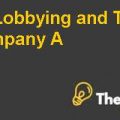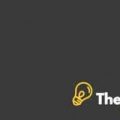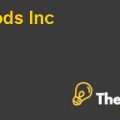craft design Case Solution
Ratio Analysis:
Liquidity Ratios:
The liquidity position of Craft Design is appears to be quite improved in the year 2016, in 2015 the quick ratio and current ratios are very low, the benchmark for current and quick ratios are 2:1 and 1:1 respectively. Liquidity ratios in the year 2015 are very low as compare the benchmark, however, in the year 2016 these ratios are almost align with the pre-defined threshold. The liquidity position of Craft Design appears to be quite satisfying which suggests that Craft Design have enough current assets to meet-up its current liabilities.
Profitability Ratios:
The profitability position of Craft Design is not up to the mark, all the profitability ratios are decreasing in 2016 which indicates that Craft Design is not performing as good as it was performing in the year 2015. The gross profit margin is decreasing by 2% which is not much high, however, the net profit margin of Craft design appears to be substantially low which could be an alarming situation for the company, slight reduction in the sales revenue or net profit could affect the profitability position drastically. Similarly, return on assets and return on equity also appears to be quite low.
Efficiency Ratios:
A/C receivable turnover days are almost same as the previous year, this depict that management is taking same time to recover from the debtors as they were taking in the previous year. The inventory turnover ratio is reducing drastically which appears to be good for the company because the holding cost will be reduced as a result of lower inventory turnover ratio. Lastly, the A/C payable days are also reducing drastically, settling the creditors early may allow Craft Design to obtain early payment discounts which ultimately increases the profitability position of the company.
Solvency Ratios:
The gearing ratio is increasing this might have certain implications on the profitability of Craft Design as they have to pay additional cost as interest, as the profitability is very damaged further long-term loan could also reduce profitability which would be dangerous for company. The interest cover ratio is also reducing which depict that Craft Design have profits which are just twice more than the interest payments.
Growth Ratios:
The growth in turnover can be said as good but not excellent, it can be said that in order to improve the profitability the management must have to undertake aggressive strategies to increase the revenue. The gross profit is also increasing by just 5% which is not in line with the increase in turnover, this indicates that cost of sales are also increasing but this could be due to factors which are outside the control of Craft Design such as inflation. The net profit margins appears to be quite negative, the decrease in net profit margin is very large which indicates that non-operating expenses are increasing extremely which is not good for Craft Design and management must have to take several steps to reduce this threat to acceptably lower level.
Further Information is necessary regarding the industry averages in order to analyze the performance of Craft Design more critically. Industry averages will play an important role in evaluation of the performance because the information will depict the exact position of the industry.
Differences Between Financial and Management Accounting:
Financial Accounting:
Financial accounting is mainly used to provide and present information about the financial position of the company mainly to stakeholders outside of the organization such as shareholders, loan providers, regulatory authorities, customers, suppliers and potential investors. Reports which shows the financial position of the company are required to be audited by an independent auditor and must be available to the public and stock exchanges and are mainly prepared on the basis of specific requirements
Management Accounting:
The focus of management accounting is mainly to assist management of the company in making decision regarding the operations of the company and Craft Design are not required under listing rules and corporate governance framework to maintain management accounting reports. Management accounting also focuses on both monetary and non-monetary factors while financial accounting mainly focuses on the monetary factors. Furthermore, there are no specific guidelines and rules available which have to be follow in any condition, every company has its own management accounting function which mainly depends on the nature of operations. In addition to this management accounting is solely for management and they don’t have to present their reports to any party outside of the organization.
Weaknesses of Traditional Budgeting System:
The main weakness of traditional budgeting system is that it is too inflexible and rigid, it only define the percentage of expenditure which can be irrelevant in case where the inflation rate is quite volatile and the goals can easily became unrealistic which causes de-motivation and frustration among the employees and management. In the recent survey of APQC, it was concluded that almost half of the respondents responded that assumptions which were used in making of the budget differs so much from the actual targets.
Furthermore, setting the percentage of budgets might causes friction among the management, it is highly likely that conflicts may arise in setting the percentages of budgets, the conflicts may arise between the departments which will result in the under performance of different departments. On the other hand the traditional budgeting system may become quite complex at the time of implementation and at the time of deciding the amount of percentages as well.
Another main weakness of the traditional budgeting system is that it based on the historical data rather than the future oriented data which might result in the unrealistic targets. Additionally, now a days companies make their budgets on the basis of the companies operating in the same sector which might again result in the some inefficiencies in the achievement of budgetary targets. These kinds of budgets can become easily obsolete and ineffective when the changes in the operating environment of the entity are quite high.(Lynch, 2011)
Another problem with the traditional budgets is that the performance of employees are evaluated on the basis of meeting the budgeted targets, this also have certain negative implication on the performance of the employees in many ways. Firstly, the employees may execute their duties just to meet their targets and to avoid punishments rather than delivering value to the organization, for example, the employees of cost centers just want to minimize the total costs without giving proper consideration to the quality of their work. Similarly, the manager of revenue center only focuses on to reaching the budgeted targets and this might enforces them to increase sales in fraudulent manner. On the other hand if the traditional budgets are prepared by top down approach it is highly likely that unrealistic targets would be set for the lower management which are just impossible to be met, these situations might lead to de-motivation among the employees which ultimately undermines the performance of the whole company. The management can be easily distracted from the main objectives of the company if the performance of managers and employees is solely evaluated on the basis of the achievement of the targets which are presented and imposed on them by traditional budgeting.(Ashe-Edmunds, 2013)
CRAFT DESIGN Harvard Case Solution & Analysis
The traditional budgeting system is also ineffective when the entity is operating in a highly dynamic industry and where the production systems requires continuous innovation. As the budgeting system are mainly base on the limited factors this might fails to recognize the factors which needs to assessed more frequently.......................
This is just a sample partial case solution. Please place the order on the website to order your own originally done case solution.










